To those of you who receive my posts by e-mail, my initial post accidentally did not include my numbers chart – sorry about that omission!
Until we went to the Durham Museum, I never had heard of the Trans-Mississippi and International Exposition and Indian Congress. This immense international event was hosted by Omaha right before the turn of the century in 1898. The Durham captures the feel of the experience of this international gathering with its model and excellent collection of photographs and narratives.

Display at the Durham Museum (Photo Credit: Nebraska Tourism)
What struck me about the whole event was how temporary and superficial the buildings were. If you drove down to the expo area, there is no longer any evidence of the grandeur that used to be, other than a possible dip in the road where a big lagoon used to be. In fact, one one Omaha blogger went back and took pictures of the places that replaced the expo building. A very interesting chronicle of bringing the past to present. As far as historical reference, the Omaha Public Library has an excellent online digital collection of the whole Expo experience.

including this excerpt on the main architect, Thomas Rogers Kimball. He had designed the house of the organizer, Gurdon Wattles previously. This put him in excellent stead to be a co-architect, devoting two years of his life to this venture. This narrative explains how the buildings were designed.
The buildings were constructed of strips of wood covered with a mixture of plaster and horsehair. They were temporary by design, built at about half the cost of permanent buildings. The lower the cost allowed the construction of larger structures.
The goal was for this event to make money, rather than cost money. Elaborate structures would motivate people to come to the experience. This 4 month event took over Omaha and changed the landscape. But only temporarily. As around a year later, according to the city of Omaha, the buildings were demolished. They took longer to build than they did to stay.
Because this event happened recently enough and was on such a grand scale, the photographs of the experience are numerous. Rather than recapping the whole experience, I will be providing many links at the end of the entry for those of you who have the time and the interest to learn more. I will give my own take from two different angles.

Photochrom print of the Grand Court of the Trans-Mississippi and International Exposition
First: By the numbers. (In high school, I used to be the basketball statistician. While parts of math, such as geometry, scare me a bit, there is something about seeing numbers organized on a chart that still make me a bit giddy.) How the experience makes sense to me!
Nebraska History search: “Triumph of the West” Nebraska History pdf article
| Event | Trans-Mississippi and International Exposition and Indian Congress | ||
| Construction Dates | Began in 1896 – finished by opening June 1, 1898 | ||
| $ Raised/Set Aside | Around $500,000 was appropriated and funded from other states | ||
| Number of Buildings | At least 46, including restaurants, arches and operations | ||
| Space Required | About 108 city blocks – just less than 200 acres | ||
| Operating Dates | June 1st – October 31st, 1898 (the last date being Omaha Day) | ||
| National Participation | 28 of 45 states; 3 territories and Pottawatamie County separate display | ||
| Internationals | Official: Mexico; 10 other countries sent private exhibitors (see p. 15) | ||
| Visitor Statistics | 2,613,508 people visited the 4,062 exhibits, receipts $1,977,338 | ||
| Admission Costs | Varied on the time and date; Advance passes: sold at $20.00 for 100 admissions, $12.50 for 25 admissions; employment passes $1.50/$2; prices varied beyond this – discounted for children was $.15 on one day | ||
| Indian Congress | Around 450-500 individuals from 23-28 different tribes (differing info.) | ||
| Photographs | Over 1800 by official photographer, F.A. Rinehart (500 of Indian Congress) | ||
Second: Events I would not have wanted my kids to miss. Our pretend field trip to the Trans-Mississippi Expo.
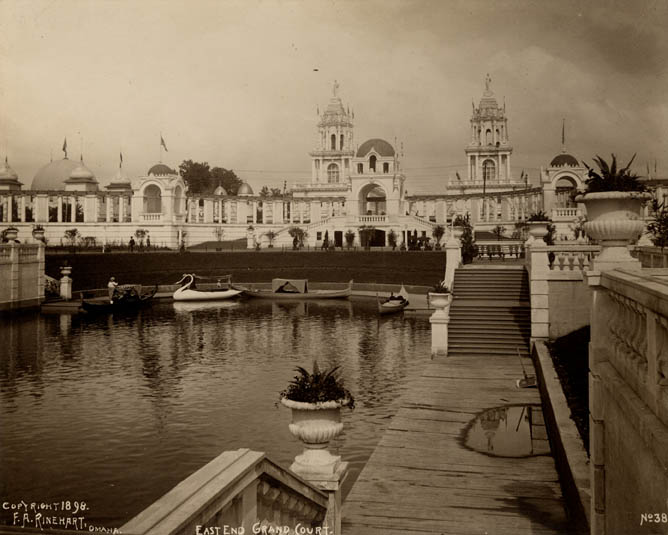
First, we would take a ride in the swanboats! (These could be found in the nine foot deep man-made lagoon. A tour about the grounds by water).
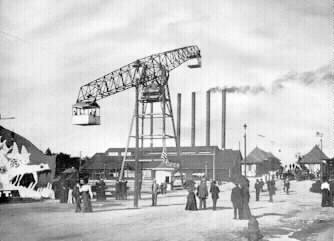
Next, we would take a ride on the giant see-saw.. If we were lucky, maybe we would be there on a day when a couple was getting married at the very top. Who knew that destination weddings were also a thing of the past?

We would have all enjoyed seeing the giant wigwam. the official exhibit of Council Bluffs. The first two floors were exhibits, and the remaining floors provided resting places for the visitors. (Picture from the Omaha Library).
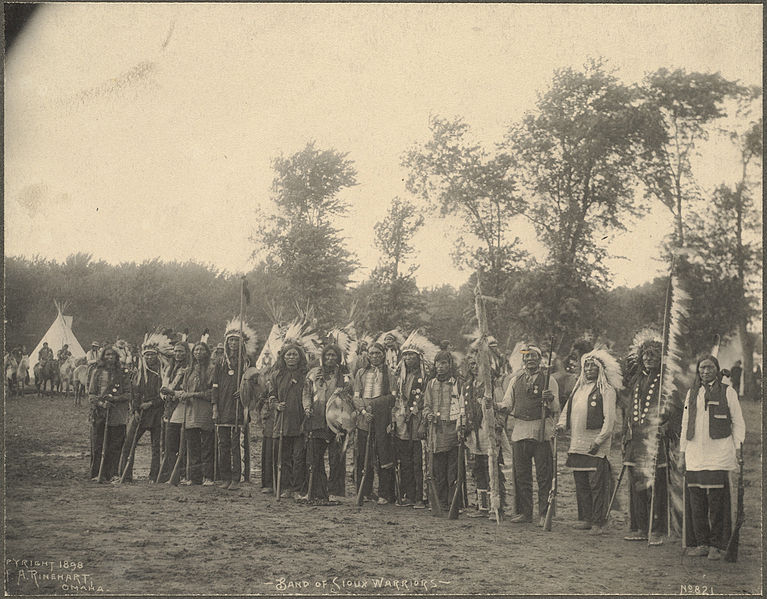
I know that my husband and boys would have wanted to meet a real, live Indian. This experience would have been thrilling for them. Not such a great ending for the Native Americans, as soon after many were sent off to reservations.
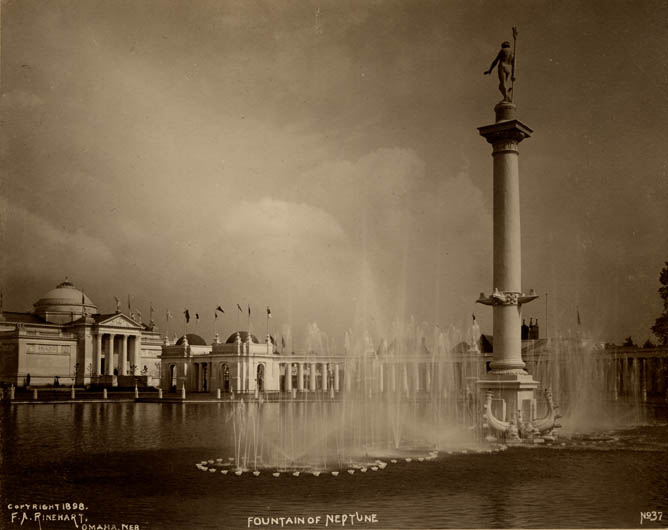
My daughter would have enjoyed seeing the Fountain of Neptune. (Although I have a feeling I might have been covering her eyes for the statue part!) I think that action would have been a bit tame compared to the reaction of two ladies of the Salvation Army. They went after two other statues featuring unclothed women with an ax and were given jail time and a $75 fine for their efforts.
Yes, there would have been parts that were not as family friendly – the dancing girls, and the supposedly free vat of wine at the California exhibit would have made me a bit nervous, not wanting my young children to imbibe. (This fear proved to be false – the exhibit did not have any drink. But this did make the Prohibitionists at the time rather fearful of this being a reality!)
At least four days, we would have wanted to attend …
Fourth of July! 45,000 people enjoyed a parade. The grounds were filled with red, white and blue. And a military band played on. Fitting since the nation was actually in the midst of the Spanish-American War. In fact in the middle of the day, good news reached the grounds …
When the early afternoon papers reached the grounds bearing the news of the destruction of Spanish Admiral Cervera’s fleet and of General Shafter’s ultimatum to the Spanish army in Santiago, bedlam broke loose and tremendous enthusiasm found expression in cheer after cheer.
A spectacular display of fireworks and illumination of the Mid-way ended this patriotic day.
August 31st: As I mentioned in a previous post, I wanted to take my kids to see Buffalo Bill’s Wild West Show. On this date, that wish could have come true as he brought his extravaganza on display before an adoring crowd.
October 12th: The day the President came to town! Actually , he had arrived with much fanfare the night before. But the 12th was his day to be featured. His time in Omaha involved a speech. And a reception where he met the prominent people. And a carriage procession. And a meeting of Indians (including Geronimo) – he also watched Indian battle re-enactments. Meals had been perfectly planned (frog legs included), and the guests were seated according to prominence. While we probably would not have made this list, William Jennings Bryan did. Would have definitely enjoyed meeting him. And dining with the President had to have been an enjoyable experience. The evening was capped off with fireworks.
(To read more about 7/4 and 10/12, check out the links above or read chapter 22 “New White City” in the book, A Dirty, Wicked Town: Tales of 19th Century Omaha by David L. Bristow).

Grand Court Looking West at Night
One last day we would have definitely attended: October 22nd: Children enter free day! (Hey, as a homeschool mom who wants her kids to have lots of experiences, free is a good price 🙂 )
In case you would like to learn even more, many resources are available.
Books:
Historic Photos of Omaha by Jeffrey Spencer (pages 72-95)
Historic Omaha: Illustrated History of Omaha and Douglas Country by Bob, Hugh and Pegeen Reilly (pages 34-39)
Omaha’s Trans-Mississippi Exposition by Jess R. Peterson
Additional Web Resources (Beyond the links in the article above):
NET coverage (includes link for documentary on Omaha 1898 World’s Fair)
HistoricOmaha.com (4 pages of online photo galleries)
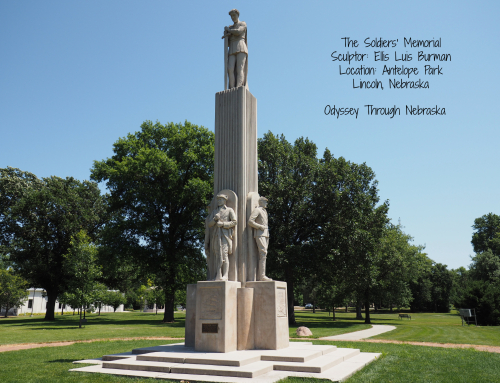

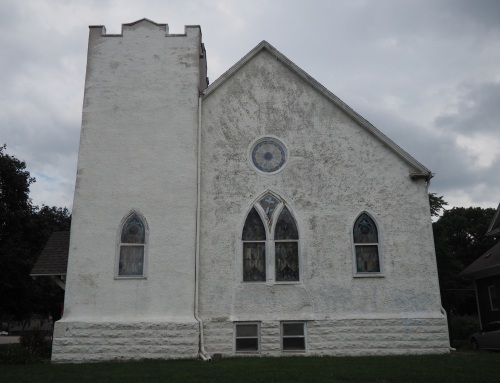

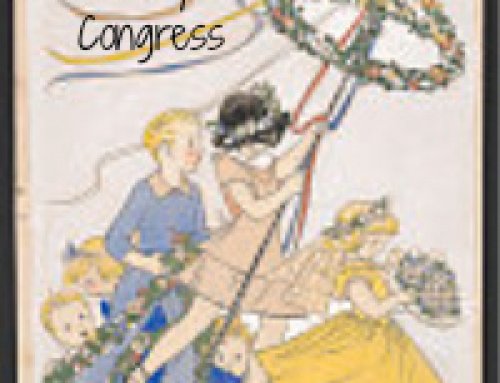
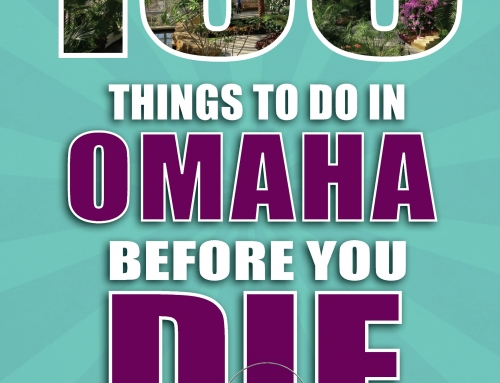
I love this exhibit! My kids almost cringe every time we get to this side of the museum. I’ve been known to spend “too much time” in there. The whole thing intrigues me. The acual expo, the architecture, even the work it took to build the scale model. I would have loved to have seen it all in person.
I have also been guilty of the same. Everyone else kept going through, and I just camped out there wanting to read everything. At least other adults were along, so I could get away with doing that! 🙂